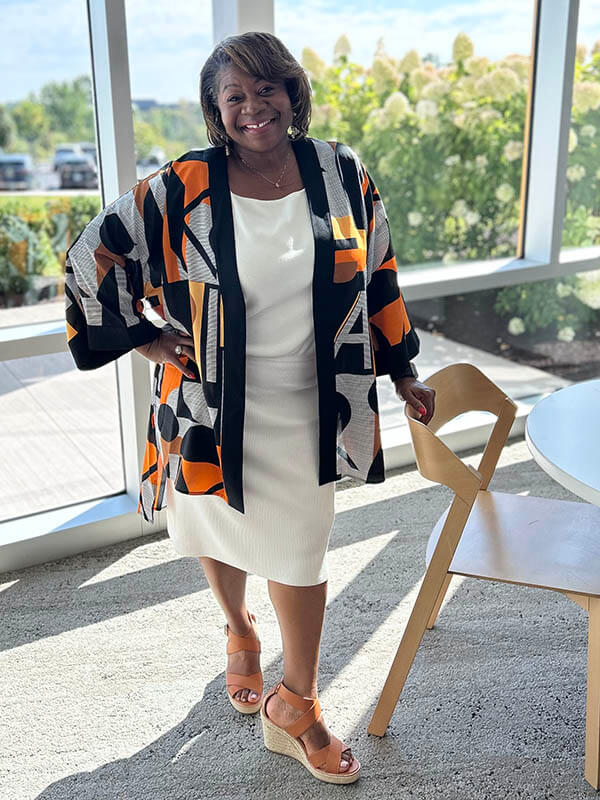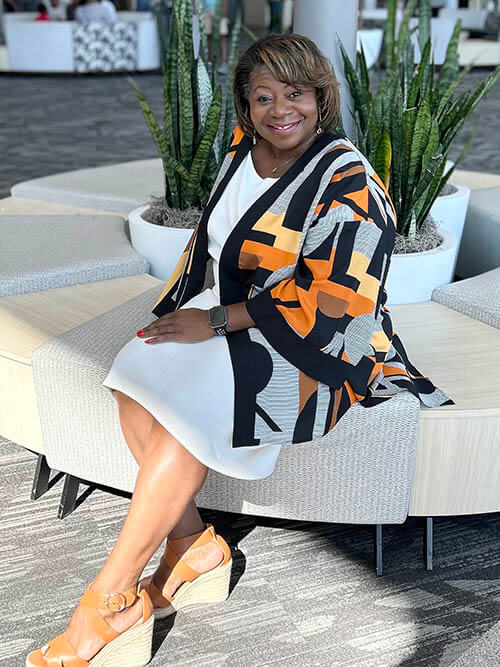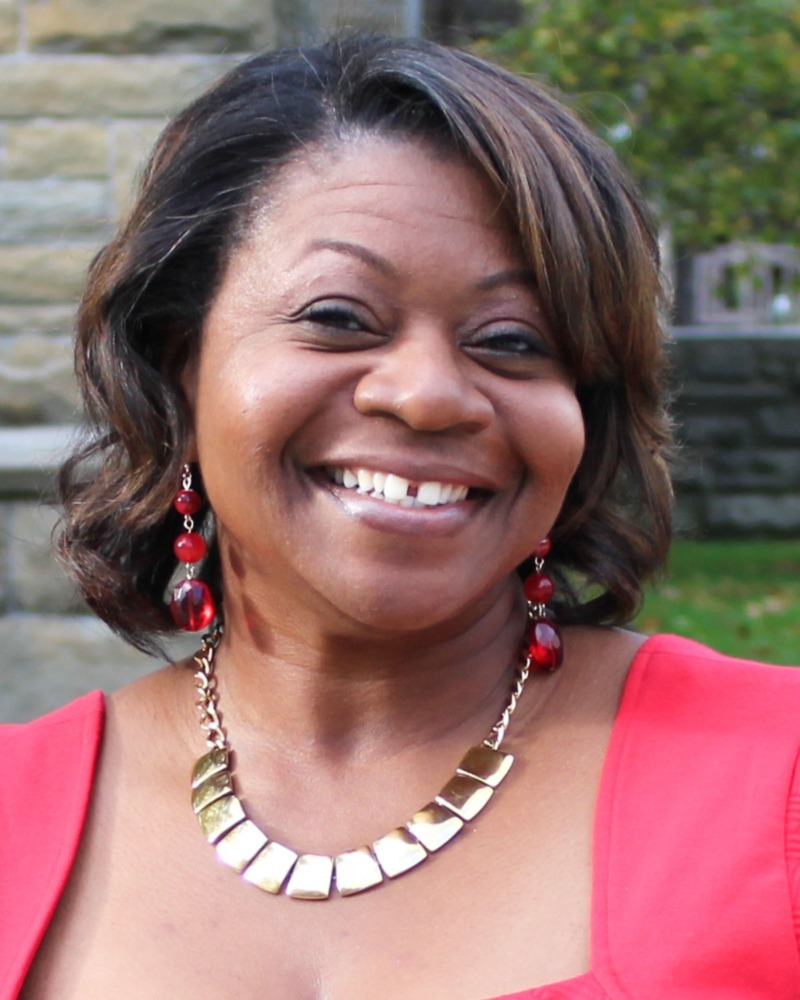Over the past two decades, Donyale R. Padgett, Ph.D., has seen Wayne State University from any number of perspectives, first as a student, later as a faculty member and now as an administrator. Recently named the interim chief diversity officer, Padgett has hit the ground in a headlong sprint, meeting with newly minted President Kimberly Andrews Espy, Ph.D.; faculty members; and students to determine how to make the greatest impact over the course of the year that she will hold the post. Padgett sat down not long ago to discuss the goals of her new mission, the challenges she faces, the impact she hopes to have on campus and in the community, and the overall state of diversity/equity/inclusion efforts in the post-George Floyd era. As has been the case for more than 20 years, Padgett remains firmly focused on WSU.
There’s a lot of conversation about DEI these days. What does chief diversity officer mean to you?
 DONYALE PADGETT: To be the “chief,” as the provost calls me, is to be the keeper of initiatives on campus that are dedicated to helping people feel connected and helping people feel like they belong here. The chief diversity officer (CDO) is the steward of this work. The work is so important. One of the things that I learned watching former CDO Dr. Marquita Chamblee through this process was how to see this as an umbrella for so many other things that are happening on the campus.
DONYALE PADGETT: To be the “chief,” as the provost calls me, is to be the keeper of initiatives on campus that are dedicated to helping people feel connected and helping people feel like they belong here. The chief diversity officer (CDO) is the steward of this work. The work is so important. One of the things that I learned watching former CDO Dr. Marquita Chamblee through this process was how to see this as an umbrella for so many other things that are happening on the campus.
What do you mean when you say, “the work?”
PADGETT: I’ve been here for a long time. I was here as a student. My first two degrees are from Wayne State. Bachelor’s in journalism, master’s in organizational communication. I kind of grew up coming to this campus, attended summer camps when I was a kid and took music lessons through the music school as a kid. I went to school here and came back to teach after completing my doctorate at Howard. So, this has been just more than a 20-year journey for me on this campus. I’ve worked and I’ve gotten to this point where I have achieved tenure. One day, somebody put it in my head that, ‘Hey, there’s a taskforce focused on diversity issues on campus, and I think you would really be good for this work.’
So, here I was with different people on campus who would later become my comrades. We were talking about how to really create a culture shift on the campus, designing an environment where we could move away from what was happening then with low admission and retention rates for some student populations — particularly African American students at that time. So, that’s where the work began for me. The work became this other day job that so many of us committed to, embarking on the process of culture change. So when I say, ‘the work,’ that is more what I’m talking about —collaborating with like-minded folk, talking about what our priorities are. Asking important questions about what we want to be and how we begin to create culture change on this campus.
One of the things that I started seeing was that there’s so much that goes on here. We have people doing DEI work in their different sectors across the entire campus, but not a lot of that was being talked about in terms of collective effort or strategic vision.
That’s the history of DEI work on this campus. Somebody has an issue, where they see a challenge, and they develop a program that begins to address a problem. We’ve always been this dynamic place as a university, but we needed a central office to leverage this work and someone to kind of bring leadership to all of this. That’s how I see the chief diversity officer position, as that person who is the guide, who is, to many, a confidant who can help lead the work of culture change on this campus. Dr. Chamblee started that work, and I see myself as taking this work to the next level of change. It is an awesome responsibility.
You mentioned your predecessor, who did a lot of good things here. How will you be different?
PADGETT: I think the question is: How am I different? So, instead of how will I be different, I think it’s ‘how am I different?’ Dr. Chamblee operated with a lot of humility on this campus. She listened more than she was interested in talking, and she would allow people to talk about what the possibilities could be without telling them what they need to be doing. And for me, I don’t have as much patience in the work. When I look at the process, I want to see collaboration. I’m a highly collaborative individual. I don’t want to be sitting there by myself. I want to be sitting there with people who are just brilliant and innovative in their minds to help think this through. 
I saw Chamblee as a caregiver in this work. Her presence reminded people who thought that they were by themselves in their silos that they were not alone. I think her perspective was, ‘I may not have a million dollars in resources, but I’m here with you in the work.’ In contrast, I want to see a network. When I visualize DEI work on this campus, I am seeing a level of energy that moves across the institution. That’s what I see: a level of energy that is active. We need this office to bring us together so that we can do larger-scale initiatives on this campus for the greatest number of people.
What are some of your top priorities as you settle in this position?
PADGETT: I think one of my top priorities was to meet and empower the Diversity, Equity and Inclusion Council (DEIC). Right before Dr. Chamblee retired, she impressed upon me the importance of getting the DEIC’s policy signed by former President Wilson. That was her last request – to take something she had begun and get it down the line. That was one of the first things I did in my first few weeks in this role. We now have a formal policy that underscores the importance of the DEIC on this campus.
And President Wilson), before he left, signed off on it. I saw him one day, and we were moving toward each other. He looked at me and he was saying, ‘Oh, I wanted to greet you.’ And I was like, ‘I’m looking for you.’ I had the policy in my hands, and I told him what I needed. He said, ‘Let’s do it now.’ And that’s my personality anyway — There’s no time like the present! Let’s go! We went to his office, and he signed the policy. It was a moment for me because it put a stamp on so much that we had been trying to do.
I have given the DEIC a formal charge and they are empowered with it, doing the work. One of the first things that they will do: We have collected DEI strategic plans from the colleges and schools. Our deans have spearheaded that process for DEI strategic planning from all the colleges and schools. We have divided the DEIC into different working groups from student equity to data and metrics to communication. We must have a charge. We need to be working in concert with one another toward more common goals.
I think the second thing that is so important for me here is for us to be thinking about what are those core things on this campus — whether it is hiring and retention, whether it is increasing the diversity of our students, whether it is increasing diversity among underrepresented faculty. Whatever those things are that we need to be working on, I see this office as a resource.
Specifically, what are some initiatives you’ve got planned already?
PADGETT: We are planning a second climate study this academic year. We would like to look at people’s perceptions on this campus about how connected they are to the university and to each other, and then the level of engagement around DEI-related issues of respect, accessibility, effectiveness of resources and belonging on the campus. We learned a lot about our campus stakeholders from the previous survey. It taught us that people experience the campus differently based on their varied identities. For instance, we learned that many people on campus did not know where to go to report incidents of bias and other misconduct. Even when there are resources available, people need to know how to access them. We learned that staff want increased opportunities for professional development and that we have some cultural competency gaps. We hired an intercultural training director last year. We learned that people on our campus who are differently abled felt a lower sense of belonging and satisfaction. We now have an Accessibility Task Force. So, it might be interesting to see — even with COVID — how our community perceives the campus today.
What do you see as the biggest challenges that you face right out the door?
PADGETT: Well, I think one of the challenges that any of us in a role like this face is feeling like we’re making a difference. It’s a challenge in this work that we are perpetually doing things but not seeing enough movement.  I think some of that has to do with maybe not evaluating and assessing what we’re doing and the difference it is making. What impact is it having? I also would want us to assess things like programming and broader initiatives. We need to do more to help people along their DEI journey.
I think some of that has to do with maybe not evaluating and assessing what we’re doing and the difference it is making. What impact is it having? I also would want us to assess things like programming and broader initiatives. We need to do more to help people along their DEI journey.
Two of the things that are important to me that are kind of like philosophical values when it comes to thinking about diversity, equity, and inclusion: self and others. What am I doing to develop myself? This is about whether I am moving the needle on self-development. Am I developing into the person that I want to be? Am I proud of the person I see in the mirror? The second aspect is: Am I impacting my immediate environment? This work is actionable. I don’t think we can be as impactful in the broader community until those two things are core. We’re in a moment where it’s important to help people understand how we’re impacting because there’s so much struggle and strife around this work.
What are some of the greatest strengths that are already in place?
PADGETT: I think one of them by far is OMSE, our Office for Multicultural Student Engagement. If you think back to 2015-ish, we had an inaugural chief diversity officer for the university. And then, immediately, it was almost like in the same sentence we were saying, ‘Oh, and we’re establishing the Office for Multicultural Student Engagement.’ And it was like, ‘Oh, okay. Well, what is that supposed to be?’ Now we have the very capable Stephanie Hawkes as senior director of OMSE, and they have almost single-handedly tried to kind of weave a web, if you will, on this campus to make sure that students, regardless of how they identify, have a place, have a space, and have experiences that keep them moving toward their goals.
They have tried to provide so many things to our students. I want to be here to relieve some of that pressure. I have a year, but I am working this every day like it’s my permanent job. That’s the only way I know how to do it
We now have an intercultural training director. So, I want to see more from that work, where we’re doing more interactive kind of dialogue on this campus in a way where people are not reluctant to go to a session for fear that they’re going to offend someone. This is the place where you get uncomfortable and take your stuff off. Each of us in this office is certified to help individuals and small groups with the intercultural development.
You just had a new president sworn in, President Espy. You give the impression that she’ll be supportive.
PADGETT: I do feel our new president will be supportive. And the conversations that I’ve had with her so far confirm that she understands the importance of DEI in this moment. After one of my first meetings with her, she pulled me to the side and said, ‘Donyale, I understand DEI and I want to help you grow it here on this campus.’ She’s had a lot of experiences in her educational journey, including being in different roles and in different campus environments.
Through some of her initiatives, we’ll have access to a lot of national resources and be in conversation with other schools that are doing similar things. I’m going to be glad to tie into some of those resources. But that’s just one example. It was good to see that there’s a high level of energy here because we need to tap into that kind of energy.
These days, we are looking out on a world where DEI — which had once been embraced very vigorously by a lot of our institutions, post-George Floyd — is now being cut from budgets. Companies are releasing their chief diversity officers. Diversity, equity and inclusion does not appear to be the priority for many of these institutions that it once was. How do we as a university ensure that we keep DEI front and center, that it remains a priority and that we don’t fall into that one and done kind of category?
PADGETT: I think first, we must be prioritized from the top. A few years back, with the events after George Floyd’s murder, a lot of organizations made a commitment to DEI. Magically, it became a priority. I think people had the wrong expectations. This is not some kind of feel-good movement. Organizations made declarations and pledges to do better. Then things started to kind of dial back. A DEI mission is an imperative and it is something that should go alongside an organization’s broader goals. Our very existence is a part of our social responsibility.
DEI is not something that you can just put on and take off. It is one of those necessary elements in any organization, because one of the things that we know is that living in a diverse world is not going to change.
There isn’t a topic that you can come up with in a meeting that doesn’t relate somehow to diversity, equity and inclusion. DEI touches everybody. A commitment to DEI is a commitment to the next generation. We’re creating the world now that they will live in.
